Panasonic Toughbook CF-NX2 Let's Note Personal Impressions
At once I will make a reservation, in this review there will be no tests for the performance of iron, battery, etc. I have neither the time nor the appropriate software, nor the experience to conduct them. You can see technical reviews of the “western” brother of this model with an SX2 optical drive like this . Here only subjective impressions of the use of the Japanese business rugged model of the Panasonic Toughbook CF-NX2 will be described.

Somewhere in the middle of 2008 I purchased the Panasonic Toughbook CF-R7 at Conics and used it for about 2 years. The computer turned out to be very convenient to use, was almost in his pocket, weighed 850g, the charge to it was tiny and there was no sense in wearing it because it was almost always enough for a working day, i.e. 6-7 hours of coding with WiFi on. 10 "screen 4: 3 allowed to write code quietly.
You could also drop it on from the height of the desktop, spill drinks on it, take it in your luggage in a suitcase and accidentally sit on it. I did not do either one, but I did not stand on ceremony with him either. Despite the absence of a camera and a microphone in it, I must admit that I have not had such a successful experience, or rather the pleasure of working with a laptop, before or after. Although after it I had a Sony z112 and a MacBook Air 11 ", quite expensive and quite decent in all respects, but neither one nor the other was as comfortable. Thirteen-inch Sony turned out to be very flimsy, after half a year it acquired a backlash of the screen lid, and after hitting a slightly closer bag, traces of keys remain on the screen, it is not convenient to hold on your knees and even the enlarged battery held less than the R7 with a total double weight. Air in terms of strength turned out to be better, but the charge is also quite short and all the time it seems that it will slip out of the hands or from the knees.
')
Actually, I needed all this lyrical digression to convince myself of the rather complicated purchase of a new Panasonic. Difficult as in financial terms, because It costs from one and a half thousand North American, and in logistic. The fact is that buying on the Internet, with delivery to our Palestinians, business rugged Panasonic laptops are not so simple, I know only 2 places, the aforementioned Conics and Dynamism . Theoretically, it is possible to purchase the SX2 in the “western” version with a touch screen, but it costs more and weighs more and I don’t need the touch screen optical disk at all.
In general, as soon as the opportunity arose, I shouted “for what they fought”, after a painstaking two-hour fuss I stopped at NX2 (doubted between him by his younger brothers J10 and AX2) and after talking to Brett Bent of Sonics on Skype, he made an order for customized model with pre-installed Windows 8 Pro (for some reason it was cheaper than with the 7th).
A week after the order, all changes in the basic configuration, in the form of SSD and 8Gb were made and the computer went to me FedEx. It took two days for delivery and another two days for abuse with local customs, I had to prove what to buy at retail for resale, I'm not going to. In short, at some point I was brought the box home.
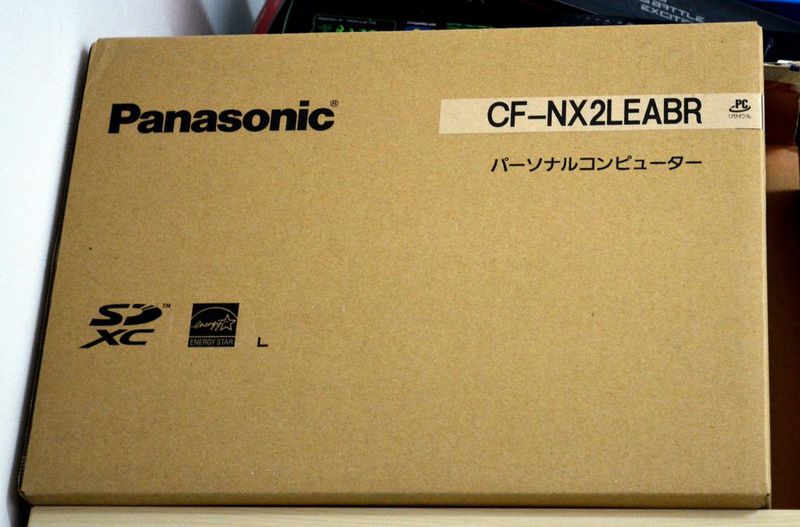 "
"
I found the hero of the review in a modest cardboard box, 2 batteries (light 6800-6400mAh and high capacity 13600-12800mAh), two charges, one is quite compact and the second is quite light (in the photo with a plug instead of a cord) and even less As I understood the second, you can only charge the laptop turned off, you can’t work and charge with it and there are many manuals from texts in Japanese and other languages of Southeast Asia.

Panasonic Toughbook CF-NX2
OS: Windows OS English Windows 8 Professional 64bit
Processor: i5 3320M 2.6GHz / QM77 Express chipset
Video: Intel HD 4000
RAM: DDR3L only 8GB DDR3L 4GB onboard + 4GB in slot
Screen: 1600 x 900, 12.1 "wide, matte
Disk: SSD 240GB OCZ AGT3-25SAT3-240G MLC
Keyboard Layout: Japanese International
Wireless adapters: WiFI IEEE802.11 a / b / g / n, WiMAX IEEE802.16e-2005
LAN: 1Gbit
Bluetooth: 4.0
Webcam: 720p with built-in microphone
External ports:
standard microphone and headphone jacks
1x USB 2.0, 2x USB 3.0
HDMI out, D-SUB out
Card slot: SDXC
Security: TPM
Batteries: 9 hours maximum (S standard battery), 18 hours maximum (L high capacity battery), both included as standard
BP: 100-240V AU international adapter x2 pieces:
- quick charge 260g with the ability to work
- light 170g, only for charging
Dimensions and weight: 295 x 197.5 x 25.4 mm, 1.09Kg with a standard battery and SSD
295 x 216.2 x 25.4 mm, 1.30Kg with a larger battery and SSD
The price in the basic configuration is about $ 1500, in the above about $ 1800.
Here is what Windows tells us about performance:
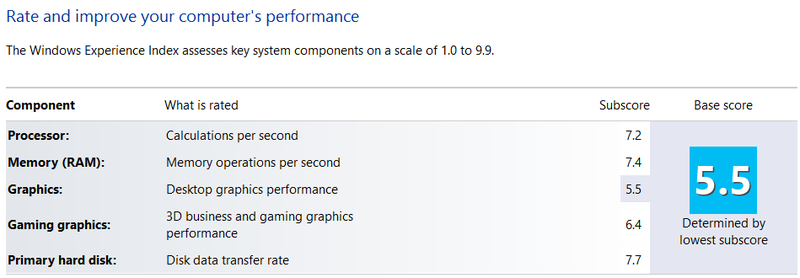
But how does it look in comparison with the MacBook Air 11 "(at the same time we will go through the external ports)
view from above":

Front face (power button, WiFi switch, headphone and microphone jack):
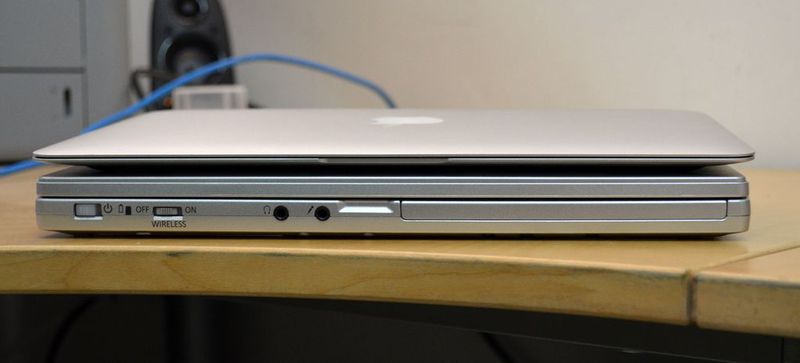
left side (lock, ventilation grill, HDMI, D-Sub, USB3 with charging, USB3)

back view:

right edge (gigabit ethernet, USB2.0, SDXC reader, power connector):
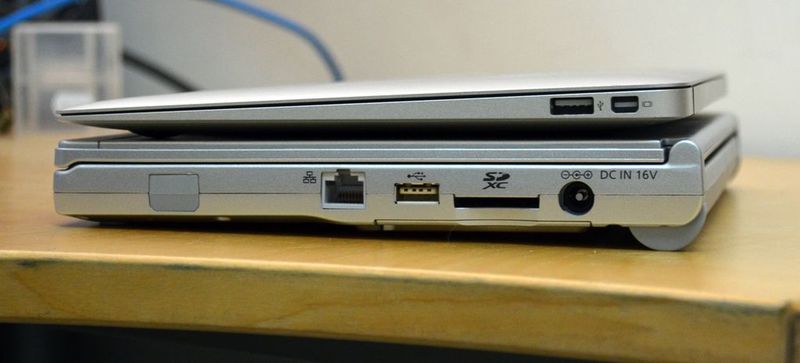
As you can see, the NX2 is much thicker than the Air, but it takes up a slightly smaller area, with a slightly larger screen. Their weight is almost the same (I have the Air model of the 2010th year), although subjectively, Panasonic seems to be easier, probably due to the fact that you do not expect such a weight from such a size. It should be noted that the quality of the screen in macbook'a above especially viewing angles, but considering that I need a laptop for writing code, I was ready to ignore this. When viewed at right angles, the picture of the NX2 is very juicy, the screen itself is dull and leans 180 * like the ThinkPads (by the way, in my opinion, the only real competitor to the NX2 is the x2xx series Thinkpads).

I write this review after two weeks of use. The machine did not disappoint expectations and did not disappoint - happy every day. The name laptop is much more suitable for this computer, because it is very comfortable on your lap and you have something to grab it with, you can work comfortably at home on the couch and sitting in a chair in a cafe. The computer is very responsive and smart thanks to the SSD, the speed of work meets modern requirements and is unlikely to differ from other ultrabooks.
The manipulator, the round touchpad, is surprisingly convenient, especially scrolling in a circular motion along the edge, also allows ordinary gestures for zooming and scrolling with two fingers, although not particularly useful due to the small area.
The keyboard is very pleasant to the touch, you have to get used to the “Japanese” English layout, of course you can stick the keys with stickers and turn them into the usual western layout, but after R7 I still have the skills, and with phonetic layouts for Russian and Hebrew, the need for stickers has disappeared long.
Japanese international layout (from seller’s website):
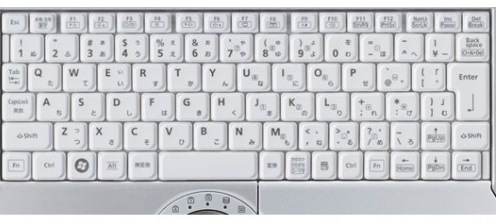
Battery life as in the case of the R7 is very impressive, the declared characteristics are close to reality. According to Bret's advice, I have included an economy mode for charging, which charges the battery up to 80% of its capacity, which prolongs the service life and reduces degradation. Until now, I used only a regular battery - 6-7 hours of writing code and compilations are enough for a typical day, peeping into manuals and reference books on the Internet and coffee and food breaks.
The price may seem overpriced at first, but given the two charges and two batteries in the kit and the total operating time of almost a day, I think this can be forgiven. The weight and “security” make it possible to carry him around with no extraordinary ceremony in circulation, and this, in my opinion, makes him a real help to the developer.

Prehistory
Somewhere in the middle of 2008 I purchased the Panasonic Toughbook CF-R7 at Conics and used it for about 2 years. The computer turned out to be very convenient to use, was almost in his pocket, weighed 850g, the charge to it was tiny and there was no sense in wearing it because it was almost always enough for a working day, i.e. 6-7 hours of coding with WiFi on. 10 "screen 4: 3 allowed to write code quietly.
You could also drop it on from the height of the desktop, spill drinks on it, take it in your luggage in a suitcase and accidentally sit on it. I did not do either one, but I did not stand on ceremony with him either. Despite the absence of a camera and a microphone in it, I must admit that I have not had such a successful experience, or rather the pleasure of working with a laptop, before or after. Although after it I had a Sony z112 and a MacBook Air 11 ", quite expensive and quite decent in all respects, but neither one nor the other was as comfortable. Thirteen-inch Sony turned out to be very flimsy, after half a year it acquired a backlash of the screen lid, and after hitting a slightly closer bag, traces of keys remain on the screen, it is not convenient to hold on your knees and even the enlarged battery held less than the R7 with a total double weight. Air in terms of strength turned out to be better, but the charge is also quite short and all the time it seems that it will slip out of the hands or from the knees.
')
Order
Actually, I needed all this lyrical digression to convince myself of the rather complicated purchase of a new Panasonic. Difficult as in financial terms, because It costs from one and a half thousand North American, and in logistic. The fact is that buying on the Internet, with delivery to our Palestinians, business rugged Panasonic laptops are not so simple, I know only 2 places, the aforementioned Conics and Dynamism . Theoretically, it is possible to purchase the SX2 in the “western” version with a touch screen, but it costs more and weighs more and I don’t need the touch screen optical disk at all.
In general, as soon as the opportunity arose, I shouted “for what they fought”, after a painstaking two-hour fuss I stopped at NX2 (doubted between him by his younger brothers J10 and AX2) and after talking to Brett Bent of Sonics on Skype, he made an order for customized model with pre-installed Windows 8 Pro (for some reason it was cheaper than with the 7th).
A week after the order, all changes in the basic configuration, in the form of SSD and 8Gb were made and the computer went to me FedEx. It took two days for delivery and another two days for abuse with local customs, I had to prove what to buy at retail for resale, I'm not going to. In short, at some point I was brought the box home.
 "
"I found the hero of the review in a modest cardboard box, 2 batteries (light 6800-6400mAh and high capacity 13600-12800mAh), two charges, one is quite compact and the second is quite light (in the photo with a plug instead of a cord) and even less As I understood the second, you can only charge the laptop turned off, you can’t work and charge with it and there are many manuals from texts in Japanese and other languages of Southeast Asia.

Specifications and equipment of this model
Panasonic Toughbook CF-NX2
OS: Windows OS English Windows 8 Professional 64bit
Processor: i5 3320M 2.6GHz / QM77 Express chipset
Video: Intel HD 4000
RAM: DDR3L only 8GB DDR3L 4GB onboard + 4GB in slot
Screen: 1600 x 900, 12.1 "wide, matte
Disk: SSD 240GB OCZ AGT3-25SAT3-240G MLC
Keyboard Layout: Japanese International
Wireless adapters: WiFI IEEE802.11 a / b / g / n, WiMAX IEEE802.16e-2005
LAN: 1Gbit
Bluetooth: 4.0
Webcam: 720p with built-in microphone
External ports:
standard microphone and headphone jacks
1x USB 2.0, 2x USB 3.0
HDMI out, D-SUB out
Card slot: SDXC
Security: TPM
Batteries: 9 hours maximum (S standard battery), 18 hours maximum (L high capacity battery), both included as standard
BP: 100-240V AU international adapter x2 pieces:
- quick charge 260g with the ability to work
- light 170g, only for charging
Dimensions and weight: 295 x 197.5 x 25.4 mm, 1.09Kg with a standard battery and SSD
295 x 216.2 x 25.4 mm, 1.30Kg with a larger battery and SSD
The price in the basic configuration is about $ 1500, in the above about $ 1800.
Here is what Windows tells us about performance:

But how does it look in comparison with the MacBook Air 11 "(at the same time we will go through the external ports)
view from above":

Front face (power button, WiFi switch, headphone and microphone jack):

left side (lock, ventilation grill, HDMI, D-Sub, USB3 with charging, USB3)

back view:

right edge (gigabit ethernet, USB2.0, SDXC reader, power connector):

As you can see, the NX2 is much thicker than the Air, but it takes up a slightly smaller area, with a slightly larger screen. Their weight is almost the same (I have the Air model of the 2010th year), although subjectively, Panasonic seems to be easier, probably due to the fact that you do not expect such a weight from such a size. It should be noted that the quality of the screen in macbook'a above especially viewing angles, but considering that I need a laptop for writing code, I was ready to ignore this. When viewed at right angles, the picture of the NX2 is very juicy, the screen itself is dull and leans 180 * like the ThinkPads (by the way, in my opinion, the only real competitor to the NX2 is the x2xx series Thinkpads).

Impressions of work and conclusions
I write this review after two weeks of use. The machine did not disappoint expectations and did not disappoint - happy every day. The name laptop is much more suitable for this computer, because it is very comfortable on your lap and you have something to grab it with, you can work comfortably at home on the couch and sitting in a chair in a cafe. The computer is very responsive and smart thanks to the SSD, the speed of work meets modern requirements and is unlikely to differ from other ultrabooks.
The manipulator, the round touchpad, is surprisingly convenient, especially scrolling in a circular motion along the edge, also allows ordinary gestures for zooming and scrolling with two fingers, although not particularly useful due to the small area.
The keyboard is very pleasant to the touch, you have to get used to the “Japanese” English layout, of course you can stick the keys with stickers and turn them into the usual western layout, but after R7 I still have the skills, and with phonetic layouts for Russian and Hebrew, the need for stickers has disappeared long.
Japanese international layout (from seller’s website):

Battery life as in the case of the R7 is very impressive, the declared characteristics are close to reality. According to Bret's advice, I have included an economy mode for charging, which charges the battery up to 80% of its capacity, which prolongs the service life and reduces degradation. Until now, I used only a regular battery - 6-7 hours of writing code and compilations are enough for a typical day, peeping into manuals and reference books on the Internet and coffee and food breaks.
The price may seem overpriced at first, but given the two charges and two batteries in the kit and the total operating time of almost a day, I think this can be forgiven. The weight and “security” make it possible to carry him around with no extraordinary ceremony in circulation, and this, in my opinion, makes him a real help to the developer.
Source: https://habr.com/ru/post/168905/
All Articles